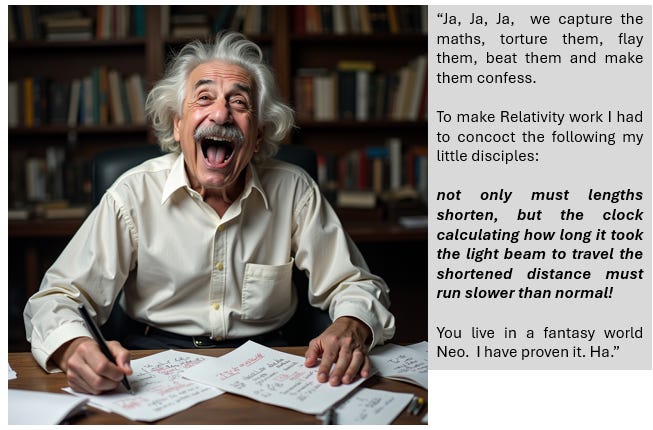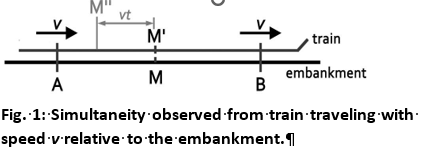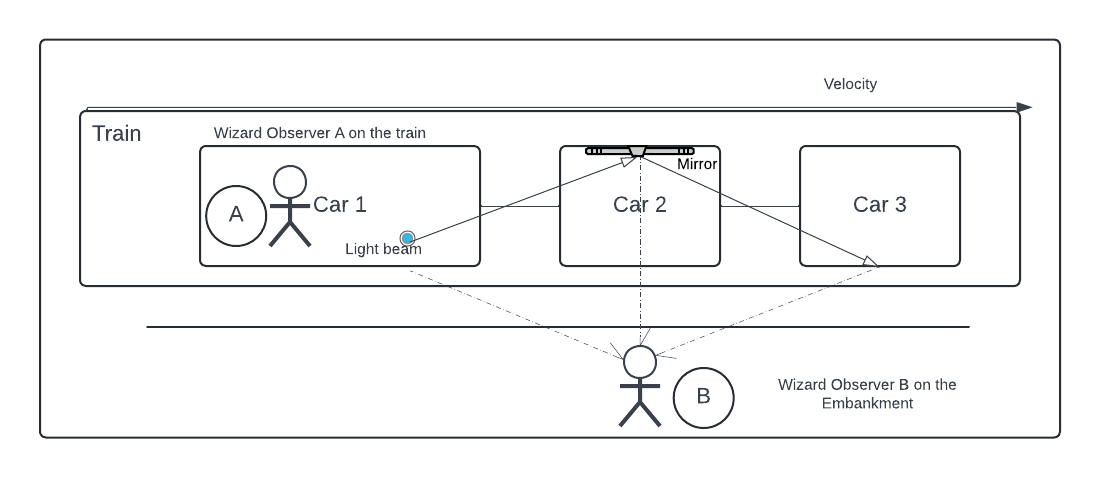Mathigicians: 'Time Dilation', when philosophy and assumptions deform 'science'.
Time-dilation is a fundamental principle of the Confusionist-Relativist and is based on a fraudulent and disproven 'thought experiment' which offends common sense.

“A more intriguing instance of this so-called “time dilation” is the well- known ‘twin paradox,’ where one of two twins goes for a journey and returns to find himself younger than his brother who remained behind. This case allows more scope for muddled thinking because acceleration can be brought into the discussion.
Einstein maintained the greater youthfulness of the travelling twin, and admitted that it contradicts the principle of relativity, saying that acceleration must be the cause (Einstein 1918). In this he has been followed by relativists in a long controversy in many journals, much of which ably sustains the character of earlier speculations … as “monstrous”. (Max Born 1956).
The ‘muddled thinking’ of Relativity, if one can term obstruse, unproven, illogical, tautological and fraudulent theory as ‘thinking’. As Born states, the idea of the ‘twin paradox’ based on ‘time dilation’ makes little sense (more below). We discussed the tautological aspects of time dilation in the previous post. In this post we will extend this analysis and eviscerate the entire concept.
The Twins Paradox and Einstein’s Illogic
(discussed here in some mathematical detail as well)
The Special Theory of Relativity (STR) proposes that fast moving objects will ‘age’ more slowly than slower objects. ‘Fast moving’ always means at the ‘speed of light’ for Einstein. A travelling ‘twin’, rocketing off into deep space, will age more slowly than the sibling twin back on Earth returning from his voyage ‘younger’ in actual age and appearance.
The ‘twin paradox’ is probably the most famous implication emanating from STR. It would mean that the age of the cosmos is extremely different than Earth time. A few thousand years on this planet might well equate into millions or billions in space time. The author fully agrees that is likely the case, but it has nothing to do with Einstein or Relativity. We can explain this from gravity and energy, and the infinite speed of light.
There is no way to verify the twin paradox of course. Supposedly this phenomenon was ‘validated’ in 1971 using atomic clocks on commercial flights but this is untrue. This experiment (Hafele-Keating) simply demonstrated that gravity and its effect on instrumentation had a small, almost infinitesimal impact on clocking within the Earth’s multi-layered atmosphere.
Given the differences in gravitational attraction and the impact on instrumentation, it should be expected that some marginal dilation in mechanical measurement would be effected. This observation was ironically, the basis of the complaint launched by Einstein and ‘the science’ against the thousands of experiments which found no movement of this planet (instrumental dilation, heat effects). What is true for thee, is not true for me…..par for ‘the science’ course.
The Hafele-Keating ‘experiment’ of course had nothing to do with ‘Relativity’, ‘space’ or relevant and large time discrepancies between Earth-bound clocks and clocks far away from direct gravitational impact. It does not mean that the actornaut Dave, in 2001 Space Odyssey, returned from Jupiter hundreds of years younger than he would have aged on Earth.
We know that Relativity itself does not support its own purported observations about the ‘twin paradox’.
Although one twin zooms away from Earth at a uniform speed near to the speed of light (which is called inertial speed in physics) in his own ‘frame of reference’, the instant that he turns around to come back to Earth means that the ‘relativistic frame’ has changed from inertial (uniform speed leaving Earth) to a non-inertial (acceleration) speed as he changes course, accelerates, increases velocity and journey’s back to Earth.
Given that Special Relativity does not include acceleration, we cannot use Relativity to answer this paradox! In other words, Einstein’s own theory disproves the twin paradox! Nice one Al.
There are 2 observations about time dilation.
Einstein’s main conception is to use ‘time dilation’ to dismiss the lack of proof that this planet moves. In particular he utilises his infamous train-thought experiments, or terrestrial bounded theorems, to ‘prove’ that an ‘observer’ on a moving object (Earth in our solar system in his mind), cannot detect simulaneous light interactions with that object. These models are 100% incorrect (see below). There is no dilation of time on this planet and simultaneous events do occur here and in space, in the absolute 3 dimensional world normal people inhabit.
Regarding space, Einstein’s time dilation comparison between space and the Earth has not been tested and never will be tested, so it is not ‘science’. However, given the effect of gravity on ‘clocks’ and time measurement, it is not entirely insensible to suppose that time moves much ‘faster’ in space, than on an energy-atmosophere-gravity rich planet like Earth. Clocks on this planet could indeed be much slower than ‘clocks’ in space. But again this has nothing to do with Relativity.
If true, this entails that the ‘billions of years’ of this planet’s existence is illogical and that the ‘billions of light years’ are reduced to the thousands. This line of thought is never pursued by ‘The Science’. Light speed is immeasureable and likely infinite. If this is true, all calculations around universal time are wrong.
As quoted above and analysed by Born and many others, if time does ‘dilate’ between Earth and space, ‘Relativity’ has nothing to say about it, and adds no value to the interpretation of why this might be true, given that the concept is negated by Relativity’s own ‘logic’.
Little Wizards and motivations
There are many disproofs of Relativity that are easy to understand, justify and confirm. One such disproof is that of Earthly ‘time dilation’. This tenet is a fundamental ‘principle’ propounded by the Einstein-Relativity cult, which has absolutely zero factual evidence to support it. This substack has discussed the ‘time dilation’ fraud in many posts (e.g. here, here and here).
It is worthwhile to summarise why Earthly-time dilation is an incoherent thought-concept, given it permeates not just science, but society at large and leads to fantastical and scientifically impossible beliefs including teleporting, multiverses, and time travel.
In 1887, Michelson and Morley ‘shocked’ the scientific world when they found no movement of this planet. Their experiment, repeated literally tens of thousands of times, has always been replicated. They found a slight ‘fringe shift’ in the light interference reading (the aether wind), but nowhere near the purported speed of this sphere as it supposedly races through the cosmos, travelling 585 million miles a year around the Sun.
The little wizards of ‘science’ had no choice but to alter time to explain away the catastrophic result of 1887 (for Copernican theology). If someone with a normal-running clock, was keeping the time of how long it took the light beam to travel through the aether in Michelson-Morley’s experiment, he would have recorded that the beam reached its destination much later then it should have. This meant that this beam would have reached its destination much later than the beam traveling perpendicular to the Earth’s motion, which would cause significant fringe shifts to appear. This could indicate Earth immobility.
So in order to have the clock accommodate an experiment in which no fringe shifts appeared, or in which slight fringe shifts were recorded (3-8 km per second, not the expected 30 km/sec); not only must lengths shorten, but the clock calculating how long it took the light beam to travel the shortened distance must run slower than normal!
Cue the Confusionists!
The Confusionist-Relativist is forced into the time-dilation position by default.
If not, the light beam will arrive sooner than it should which will upend Copernicanism including the dogma about the invariant speed of light. Therefore we now have what modern science calls ‘time dilation’. The calculation of time itself can change, and therefore it is as ‘relative’ as everything else. Light speed is invariant ‘the science’ maintains, except when the time dilates and changes, or after the Big-Bang cosmic particle explosion when light speed was infinite but thereafter at some point in ‘time’, greatly reduced! So much ‘science’.

Speed of light and anisotropy (variation in light speed inbound and outbound) and the consequences.
You can see that the time-dilation concept is unproven but philosophically imposed, given that the underlying theology maintains a movement of this planet, even though the light interference experiments do not support this apriori conclusion.
Time Dilation and Relativity
In order to wave away the Michelson-Morley failure to prove Copernicanism, Einstein in his STR was forced to deploy maths to support the idea that there is a slowing down of a clock (or time), as determined by an observer who is in relative motion with respect to that clock. For Einstein, time dilation is also referred to as a difference of elapsed time between two events as measured by observers.
But here we arrive at the fallacy of the time dilatation, from Einstein’s incorrect idea.
In a previous post we discussed the claim by Einstein in his 1948 book, The Special and General Theory about a train which moves with direct (or rectilinear) and uniform speed with respect to the embankment. Einstein maintained that the time needed for a process in relation to the car cannot be equated to the duration of the same process judged from an observer on the embankment.
We can go further. If we take this rather useless ‘thought experiment’ at face value, we see that it is the beginning of which ineluctably leads to a false conclusion, and painfully contorted and fraudulent maths. When discussing time and its change of state, one can use 𝑡𝑝 to identify the process. Another viewpoint or observation of this process can be called time 𝑡𝑜 which describes seeing this process of time state change from a different observer position.
To visualise Einstein’s train car experiment, we can make a simple image.
M=Point or location, V = Train velocity, A & B = distance points (start and finish for e.g.)
Imagine that the train has 3 train cars, attached to each other, and collectively moving down the track. Within this thought concept, there is a direct (rectilinear) displacement within the train cars, at a constant speed 𝑣.
Thin-armed Wizard Observer A, who is mounted on train car 1, fires a ray of light, which is reflected in a mirror located on the roof of the 2nd car onto the floor of car 3. A second thin-armed Wizard Observer B on the embankment, sees the ray at the beginning when it is triggered.
In this case the process consists of the round trip of a ray of light thrown by Observer A, from the base of the train car 1, to Observer B. In this mental experiment Einstein attempts to justify the time difference that exists between the two observers when measuring the duration of the light beam. According to the Einstotle, Observer A in motion on the train will clock a slower time than Observer B on the embankment.
This is fallacious for many reasons. First, Einstotle’s own canon stipulates an invariant speed of light at a rate of 186.000 miles per second. This is despite the fact that Einstein knew that light speed was variant. In this experiment, there can never be a difference in the duration or measurement of such a speed at such short distances. There is no possibility that such a velocity will vary if you truly believe that light speed is invariant.
Second, the light velocity calculation of the beam itself has nothing to do with the location of an Observer, and whether they are in motion or not. It matters nothing to ‘light speed’, or its absolute measurement, if you are stationary, moving at high speeds, or accelerating at different rates. It might matter to the observer and his calculation of distance or his assessment of light impact, but the fundamental calculation of light velocity is unaffected by Observer motion or stasis.
See the Observer fraud.
Fracture the Fallacy
This fallacious error is premised on the following.
· Einstein assumes there were two distinct times for the same process when in reality it is two observation times of a single process from two different observation points; that of the Observer A and that of Observer B who is fixed on the embankment
· Time 𝑡0 is the period of time from when the beam is triggered until it returns to the base of the train carriage
· Time 𝑡0 of the Operator A, who is mounted on the train car, is in fact the same as the time 𝑡𝑝 of the process
· Observation time, 𝑡0 of Observer B, fixed on the embankment at any point along the route, can never be assimilated to the time 𝑡𝑝 of the process
This confusion arises from attempting to consider as a single physical phenomenon, the intervention of two different physical phenomena namely:
· The reflection of a ray of light
· The movement of the train or carriage from which the light emanates and which is translated as a beam to the mirror
In a previous post we discussed ‘simultaneous’ and ‘simultaneity’. Einstein’s thought experiment confuses the two concepts.
1-Simultaneous: Two events happen at the exact same moment (denied by Relativity given that all events live in their own ‘reference frame’)
2-Simultaneity: The property or condition of events occurring at the same time (accepted by Relativity if they occur within the same reference frame, unless the action is one of moving from inertia to acceleration)
3-Synchronicity: Making sure two or more clocks read the same time, or that events measured by those clocks align (denied by Relativity which uses the Michelson Morley experiment as ‘proof’ given that the light beams arrived at the target, at different times)
Einstein mixes up various concepts to try and justify the inane claim that a single process of time can be relativised based on observer movement and location.
Bottom Line
Einsteinian Relativity proposes that time is the slowing down of a clock as determined by an observer who is in relative motion with respect to that clock. It is also defined a difference of elapsed time between two events as measured by observers. We have discussed why this concept is completely false. Long ago the world’s foremost expert on Relativity who became an apostate, Herbert Dingle, pointed out why time dilation was a chimera and why it was a disproof of Relativity.
“(Dingle) Suppose the relative velocity is 161,000 miles a second. Then, according to the theory, the time according to one clock (A, say) between the readings 1.0 and 2.0 o’clock of B is 2 hrs., so that A works twice as fast as B. This is a particular case of a general result obtained by Einstein in 1905 and universally accepted. But, similarly, the theory requires that the time according to B between the readings 1.0 and 2.0 o’clock of A is 2 hrs., so that B works twice as fast as A. (Einstein did not consider this case). These results are clearly contradictory.”
This objection still stands today. Einstein and ‘time dilation’ is yet another mathematical illusion, more muddled thinking pace Born, designed to divert your attention away from real world experiments which cannot prove Copernicanism, nor the invariant speed of light.
Time is a single process and a calculation.
Different observation points will have different perspectives on what is happening, but time and its process are an absolute measurement and calculation against an absolute and singular frame of reference and which cannot be relativised.
It should also be pointed out that the speed of light might well be infinite, immeasureable and incomprehensible, or simply ‘instantaneous’ as Galileo drily declared. This would mean that the endless ages of this planet and the universe are chimeras and falsities.
These concepts were discussed during your ‘education’ right? Critical thinking, the ‘age of reason’ and all that.
All hail.
==
Einstein, A. (1948). The Special and General Theory: Prabhat Prakashan.
Einstein, A. (1955). The Meaning of Relativity. Including the Relativistic Theory of the Non-symmetric Field, by Albert Einstein: NJ, Princeton University Press.
Viladesau, E. M. (2018). Theory of relativity-atomic watches and time dilation. International Journal of Fundamental Physical Sciences, 8(1), 1-4.
Lorentz, H. A. “Michelson’s Interference Experiment,” in The Principle of Relativity, trans. by W. Perrett and G. B. Jeffery from the 1923 first edition, 1952, p. 7.
Michelson, A. “Relative Motion of the Earth and the Ether,” Amer. Jour. of Science, vol. III, June 1897, p. 478







One thing, in my mind, is evident.
It in itself is a magic trick that few figure out how the trick is actually performed or that it is a magic trick at all.
Thanks for helping us see and understand how the magic trick is done !!!
I'd be interested in what you think of this:
'"Szirko effects" refers to a series of concepts and theories, primarily developed by M. Szirko, concerning the influence of relativistic motions in the brain and their physiological relevance, particularly regarding inattention. One proposed effect is that inattention is a common mechanism resulting from these relativistic motions within the brain.
Key Aspects
Relativistic Motions in the Brain:
The theories propose that relativistic effects—those related to Einstein's theory of relativity—play a role in brain function and cognitive processes, such as attention.
Physiological Relevance:
These relativistic motions are suggested to have tangible effects on biological processes and functions within the brain.
Inattention:
A central idea is that inattention may be a common consequence or mechanism arising from relativistic motions in the brain, leading to a reduction in focus or awareness.'
---------
'We do not live
and remember physical instants; we live and remember moments, and the
difference between an instant and a moment is a dilation that stretches
physical instants an ascertainable number of times.' Szirko.
http://electroneubio.secyt.gov.ar/Effects.pdf